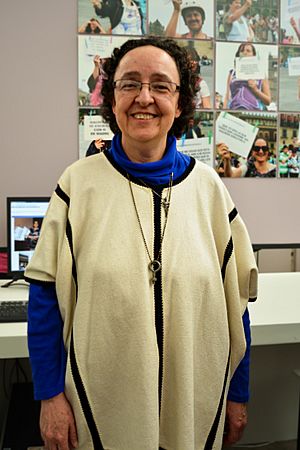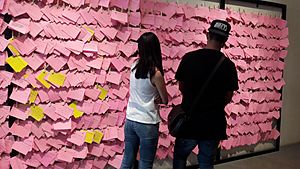Mónica Mayer facts for kids
Quick facts for kids
Mónica Mayer
|
|
|---|---|

Mónica Mayer
|
|
| Born |
Mónica Mayer
1954 (age 70–71) Mexico City, Mexico
|
| Education | Escuela Nacional de Artes Plásticas Goddard College |
| Occupation | Visual artist activist |
Mónica Mayer (born 1954) is a famous Mexican artist, activist, and writer. She uses many types of art, like performance, digital art, drawing, and photography. Mónica is also an art critic and a thinker about art.
She has been part of many art groups and has led workshops. From 1988 to 2008, she wrote for a Mexican newspaper called El Universal. Today, she still writes for different blogs. Mónica has always believed that art can be more than just paintings or sculptures. Her art often shows her strong opinions, her sense of humor, and her desire to make a difference.
Contents
Early Life and Art School
Mónica Mayer was born in Mexico City in 1954. She studied art at the Escuela Nacional de Artes Plásticas there. While in art school, she became very interested in feminism. Feminism is the idea that women should have the same rights and opportunities as men.
She joined feminist groups in Mexico, like Movimiento Feminista. Later, she earned a master's degree from Goddard College in the United States. Her special project was about how art can be a powerful tool for women's rights. From 1978 to 1980, Mónica also took part in a workshop at the Woman's Building in Los Angeles, California.
Mónica Mayer's Art Career
In the late 1970s, Mónica Mayer started making art that involved "performance." This means her art included actions or events, not just objects.
The Clothesline Project
One of her most famous pieces is called "El Tendedero," which means 'The Clothesline.' In 1978, Mónica walked around Mexico City. She gave out hundreds of pink postcards to women from all walks of life. The cards asked, "As a woman, what I hate most about the city is..."
She received many answers, and a lot of them talked about harassment women faced, especially on public transport. Mónica then hung these responses on a clothesline, just like you would hang clothes to dry. This art piece showed the problem of harassment and gave a voice to many women. The pink cards highlighted women's experiences, and the clothesline reminded people of the daily chores often done by women.
The first time "El Tendedero" was shown was in 1978 at the Museum of Modern Art in Mexico City. It was very popular, so a slightly different version was shown in Los Angeles, California, in 1979.
Founding Feminist Art Groups
In 1983, Mónica Mayer and Maris Bustamante started Mexico's first feminist art group. It was called Polvo de Gallina Negra (Black Hen Powder). Their art mixed strong social messages with humor. The group's name itself was funny: "Black Hen Powder – to protect us from the patriarchal magic which makes women disappear." They performed in the media and did other public art projects.
That same year, Mónica taught a workshop called "Women and Art." This workshop led to another feminist art group called Tlacuilas y Retrateras.
Pinto mi Raya Project
Mónica Mayer has performed her art alone and with Víctor Lerma in Mexico and Japan. Her performances are often social projects designed for specific places. In 1989, Mónica and Víctor Lerma started an ongoing project called Pinto Mi Raya. This project is mainly a newspaper archive that focuses on modern art in Mexico.
The goal of Pinto mi Raya is to help the art world in Mexico. They do this by organizing activities, workshops, and performances. They have also had radio shows and taken part in activist actions as part of the art community.
In a 1998 book, Lerma and Mayer explained their project. They said it helped them find problems in the art system. So, they decided to create art projects to help solve these problems. They wanted to make the art system work better.
Recent Work and Recognition
From 2012 to 2018, Mónica worked on a project called De Archivos y Redes (From Archives and Networks). This was part of a national program for artists in Mexico.
In February 2016, a big exhibition of her work opened at the Museum of Contemporary Art in Mexico City. It was called "Si tiene dudas... pregunte: una exposición retrocolectiva de Mónica Mayer" (When in Doubt... Ask: Mónica Mayer's Artistic Project).
In October 2016, the Women's Institute of Mexico City gave her the Omecíhuatl Medal. This award was for her "outstanding participation in education, arts, culture, and sports." It recognized how she has inspired and helped women grow and become stronger.
In 2025, Mónica Mayer received the Distinguished Feminist Award in Art from the College Art Association (CAA). This award honors people who have helped women achieve equality in the arts through their art, studies, or advocacy. Mónica Mayer is the first Mexican artist to receive this important award.
Awards and Recognitions
- Distinguished Feminist Award (Art) by College Art Association (2025)
- Medal of Fine Arts in Visual Arts by the Mexican government (2021)
- Omecíhuatl Medal by the government of Mexico City (2016)
Exhibitions
- New Tendencies. Museum of Modern Art (Mexico City, Mexico) 1978.
- Making it Safe. Santa Monica, California (USA) 1979.
- WACK! Art and the Feminist Revolution. Museum of Contemporary Art (Los Angeles, USA)
- "El Tendedero/The Clothesline Project." National Museum of Women in the Arts (Washington, DC). 2017
- "El Tendedero/The Clothesline Project." Indianapolis Museum of Art (Indianapolis, IN). 2022
Publications
Mónica Mayer has written many articles and books about art.
Books
- Mayer, Mónica. Rosa chillante: mujeres y performance en México. México: Conaculta/Fonca, 2004.
- Mayer, Mónica. Una Década Y Pico: Textos De Performance. [México, D.F.]: Ediciones al vapor, 2001.
- Mayer, Mónica. Translations: An International Dialogue of Women Artists. [Place of publication not identified]: [publisher not identified], 1980.
- Mayer, Mónica. Mónica Mayer: novela rosa o me agarró el arquetipo. México, D.F.: Museo de Arte Carrillo Gil, 1987.
- Mayer, Mónica, Víctor Lerma, and Alfredo Ramírez. Arte público en el archivo de Pinto Mi Raya. México: Pinto Mi Raya, 2002.
- Mayer, Mónica, Víctor Lerma, Alethia Edurné González Cañetas, and Alejandra Sánchez Avilés. Mujeres artistas en el Archivo de Pinto Mi Raya, colectivas y textos varios. México: Pinto Mi Raya, 2003.
- Mayer, Mónica, Víctor Lerma, Alethia Edurné González Cañetas, and Alejandra Sánchez Avilés. Ojos y vidrio: las fotógrafas en el archivo de Pinto Mi Raya. México: Pinto Mi Raya, 2003.
- Mayer, Mónica, Víctor Lerma, and Miriam Urbano Alonso. Performance en el archivo de Pinto Mi Raya: versión actualizada de Mayo de 1991 a Mayo de 2005). [México]: Pinto Mi Raya, 2005.
- Mayer, Mónica. Escandalario: los artistas y la distribución del arte. [Mexico]: AVJ Ediciones, 2006.
See also
 In Spanish: Mónica Mayer para niños
In Spanish: Mónica Mayer para niños


